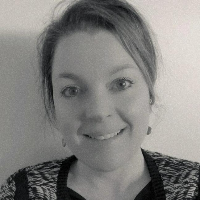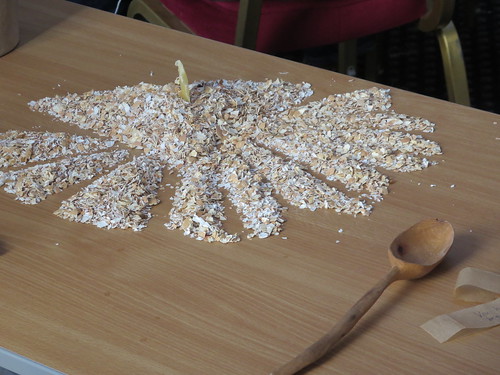| Bizarre objects covering the workshop tables. Image credit Amanda Woodman-Hardy |
Fourthland came to the Cabot Institute from London to give a workshop which would help us look into how resilience forms an important part of our research across all disciplines. Walking into the room with weird objects laid out and the sound of an Irish choir repeating a hypnotic chant, I instantly knew this would be a very different kind of exploration of our academic research.
A resilient performanceFourthland started their artistic performance by holding a rope and folding it up…cue lots of confused looks around the room and people shifting uneasily in their seats. I couldn’t help thinking what on earth have I signed myself up to?! Asking everyone to close their eyes, Fourthland continue to set up the room with props.
| Folding of rope. Image credit Amanda Woodman-Hardy |
Upon opening of eyes, everyone was asked to communicate through gestures and not use their voice. A volunteer was plucked from the room to randomly play a piano whilst participants took hay, eggshells, string and a big dish of what looked like the biggest poppadum I had ever seen – it was actually a flat bowl made from wax. Manipulating all these ‘ingredients’ separately in small groups by making straw bundles, ‘moving mountains’ with eggshells, and weaving string in and out and around the room, binding the room together, there was a sense that this had meaning in a way that could not be explained verbally. This is where writing about the experience is tough. What on earth was happening, what did it all mean and where was the relevance to resilience? I couldn’t quite see it at that point…
Fourthland continued and read from a scroll rolled up in a rolling pin. The scroll contained all the thoughts of the researchers that had contributed to our resilience programme over the last few weeks. Contributions came from social science, engineering, arts, and the sciences. After all the noise and manipulating of simple materials subsided, a group of volunteers sat at the front of the room (named the ‘keepers of culture’) reflected on what they thought had just happened.
| The Resilience Workshop at Cabot Institute. Image credit Amanda Woodman-Hardy |
Digesting the workshop
Taking the time to digest what had just happened was critically important at this point. We had spent 20 minutes inside this weird bubble of wax and string and sound and eggshells and straw and a whole load of visual and aural bombardments. How was the room making sense of it all? I was intrigued.
First reactions were that lots had happened without actually seeing it. Everyone was so engrossed in their little task with their simple material that they didn’t feel like they saw everything that was going on but everyone seemed to sense most stuff that was happening around them, regardless of whether they saw it or not. It wasn’t until everyone stopped and looked around at the transformation of the room that we all realised just how much we had changed our simple materials and our presence in the room.
| The creation of a circular straw wreath by Cabot Institute academic during Resilience Workshop. Image credit Amanda Woodman-Hardy |
| Workshop participants breaking up a wax bowl. Image credit Amanda Woodman-Hardy |
| Making straw bundles and a nest. Image credit Amanda Woodman-Hardy |
The string group, with a bundle of string and no scissors started by miming cats cradles to each other but then realised that not having scissors meant they had to think more creatively about what they were doing with the string…so they connected everyone in the room up. Once everyone in the room was connected they then turned to making the string look more attractive, embellishing it with knots and some borrowed straw. The string group felt that this process made them question permission e.g. who they could tie up with string, were they allowed to go around the room with the string in the first place? They noticed that there was a bit of risk-taking involved in tying around people and creating trip hazards. In the space of boredom they associated their permissions. No one had said they couldn’t do what they were doing, so they just assumed that they could. Thinking about resilience it was interesting to see what permission allows you to do but also where it restricts your resilience.
| Tying the room up with string and embellishing with straw. Image credit Amanda Woodman-Hardy |
| Two people worked on this pile of eggshells in silence. One thought he was creating an island, the other the sun. Image credit Amanda Woodman-Hardy |
Artistic interpretations of resilience
Academic interpretations
- One scientist thought the workshop was about the individual stories and that life was precious.
- “It was less about looking for someone else in the room who knew what was happening and more about what I knew”.
- “We took away our human stuff e.g. language and knowledge, and sought an older part of ourselves, like making eye contact in order to make and do and continue”.
- A social scientist asked about cooperation and what happens if something happens that is malign like external shocks? What happens to that group cooperation? If the shock came you would need to know that you can all come together to get over that shock.
- Another point well-made was that there was a whole load of people who weren’t in the room. “Every time we try to be resilient we are excluding certain groups”.
Future thoughts on resilience
This blog has been written by Amanda Woodman-Hardy, Coordinator at the Cabot Institute. Follow @Enviro_Mand.
 |
| Amanda Woodman-Hardy |
Fourthland conference and workshops 26 November – 29 November 2015, bookings open:
- isik knutsdotter of Fourthland: back to where we have not quite been
- back to where we have not quite been: Handed Down and Handled
- back to where we have not quite been: Public Dreaming workshop
- back to where we have not quite been: Conference
- back to where we have not quite been: Constructed by Many Mouths
- back to where we have not quite been: Visual Matrix


